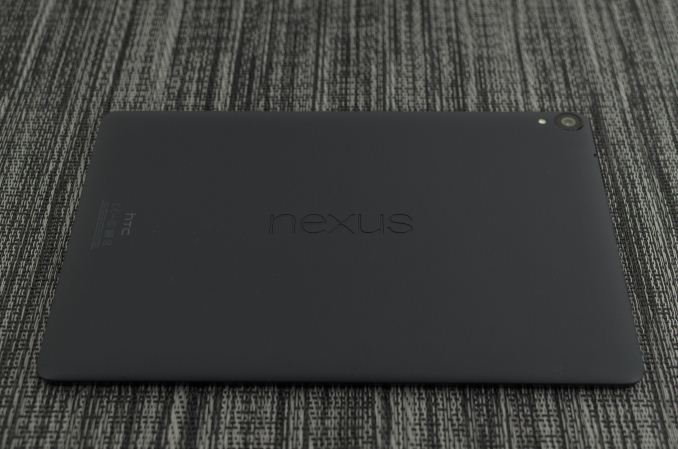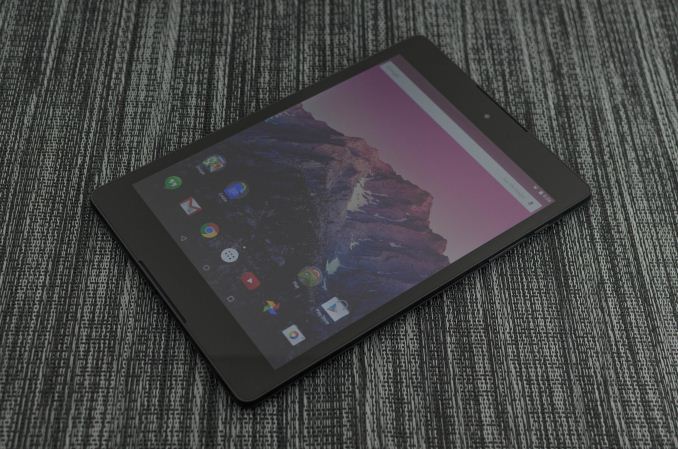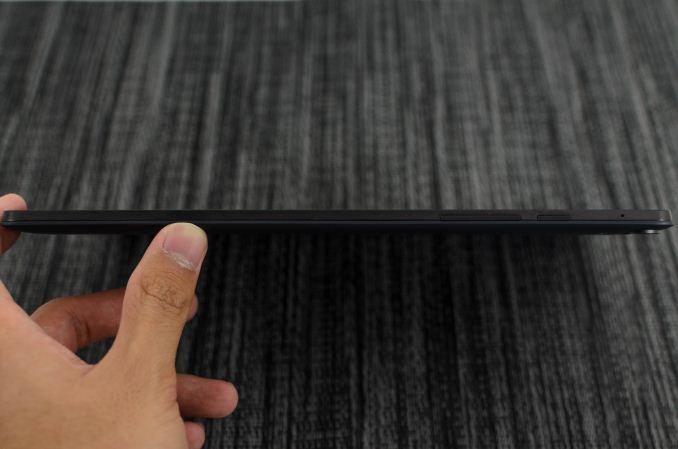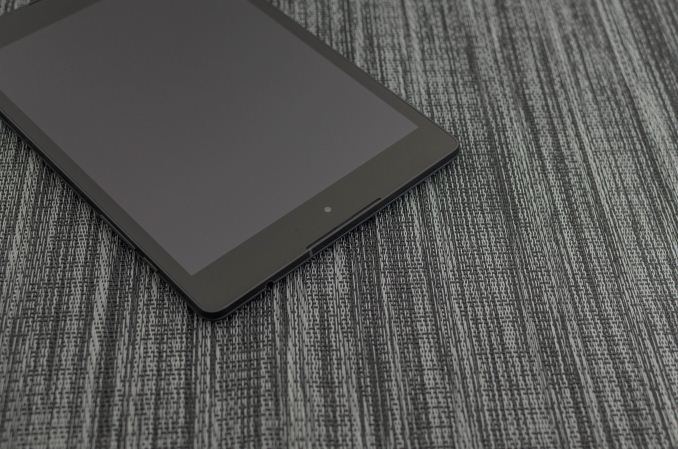Google Nexus 9: Preliminary Findings
by Joshua Ho on November 3, 2014 1:00 PM EST
For a few years now, Google has had a generally consistent tablet strategy. Instead of chasing after the ~10 inch tablet segment and focusing upon the high end, we’ve seen tablets closer to the ~7 inch display size at extremely low cost. While this has been an immensely successful strategy in driving hardware adoption, the formfactor made it possible for the tablet to be closer to a large phone than a small tablet. The flexibility of Android’s scaling system meant that an app designed for a phone worked acceptably well for a small tablet, even if the space efficiency was a bit poor. There’s no question that the Nexus 7 (2013) was and still is a great tablet, but even now it’s obvious that there’s a dearth of applications designed specifically for the larger display. The other issue is that of cost. With the Nexus 7 line, Google managed to integrate an incredible amount of hardware into a tablet priced well below the ~500 USD price point that the original iPad established. This is great for the consumer and no doubt great for Google, but the Nexus 7 line was good enough that there wasn’t much in the way of competition.
This brings us to the Nexus 9, Google’s attempt at changing the Android tablet space. From the start, this device seems to be intent on pushing the Android tablet to a more premium segment. Rather than a purely cost-optimized polymer design, we see the addition of an aluminum ring that runs around the side of the device, which definitely helps with in-hand feel. The tablet itself seems to have high-end aspirations as the launch platform for NVIDIA’s Tegra K1-64, which has two Denver CPU cores rather than the traditional 4+1 Cortex A15 setup, along with dual front-facing speakers and a large 9” display with 4:3 aspect ratio. I’ve included the basic specs in a spec sheet below, to avoid spending too much time going over the basics.
| Nexus 9 | |
| SoC | 2.3GHz 64-bit dual core Tegra K1 Denver SoC |
| RAM/NAND | 2GB LPDDR3 + 16/32GB NAND |
| Display | 8.9" 2048x1536 IPS LCD |
| Network | WiFi only or 2G / 3G / 4G LTE SKU |
| Dimensions | 153.68 x 228.25 x 7.95mm, 425g WiFi, 436g LTE |
| Camera | 8MP Rear Facing (IMX219) with F/2.4 aperture, 1.6MP FFC (OV9760) |
| Battery | 6700 mAh (25.46 Whr) |
| OS | Android 5.0 Lollipop |
| Connectivity | 802.11a/b/g/n/ac + BT 4.1, USB2.0, GPS/GNSS, NFC |
Unfortunately, in the case of the Nexus 9 while we can make some early observations the version of firmware that we received dates was built on August 29th, and in the time since it’s quite likely that there have been significant changes in all directions. We still don't have a newer build, so all the tests will be done on older firmware. The full review will have final numbers as it will be done using shipping firmware.
At any rate, the hardware of the Nexus 9 definitely fits the bill of a premium tablet. While for the most part every Nexus device in the past year has shared the same industrial and material design elements, HTC seems to have added a few extra touches to differentiate this product from other Nexus devices. The most obvious and prominent of these touches is the metal ring, which has a brushed texture similar to what we saw on the M8.
There are also dual front-facing speakers that flank the display, which are definitely great for video and music content when compared to a single speaker on the bottom or back of the device. However, for the most part the design is very much a Nexus device with its minimalistic design and soft-touch plastic back cover.













146 Comments
View All Comments
Ppietra - Monday, November 3, 2014 - link
Since the screen area difference is significantly larger than the battery size difference and both tablets give the same battery life, one can hypothesize that the A8X is more energy efficient than the Tegra k1.kron123456789 - Monday, November 3, 2014 - link
It's no surprise since A8X is 20nm and Tegra K1 is 28nm.chizow - Tuesday, November 4, 2014 - link
Again, can't make any such assumptions based on screen size alone, given early reviews show the Nexus 9 screen is brighter. Apple could've certainly put in a bigger battery or at the very least left the same size as the iPad Air 1, but I guess they wanted to trim weight and cut costs above all else.ams23 - Monday, November 3, 2014 - link
Nexus 9 has higher single-threaded CPU performance than iPad air 2 in Geekbench 3, and has higher performance in Kraken too (and possibly some other tests such as Octane). It depends on the workload and where the CPU can take advantage of dynamic code optimization.testbug00 - Tuesday, November 4, 2014 - link
based on some broken down geekbench single core, the Nvidia chip has about the same IPC in integer (~2800/2.2 Divided by ~1800/1.4 == ~99%) but, it has a huge deficit in FP (~1200/2.2 divided by ~1700/1.4) of only about 45%.Numbers ran in 32 bit for K1 as the 64b Android version that supports the K1 appears to not be functioning as it should. NVidia's numbers should improve a bit, probably to 100-115% of Int and 50-65% of Floating Point.
(The output is Tegra K1 Denver core having 99% Integer and 45% based on multiple-core scores PER CORE of Apple's tri-core A8 chip (~5200/2300 used for Tegra, ~5100/4900 used for tri-core A8)
Ratman6161 - Monday, November 3, 2014 - link
Also don't forget it's Android 5 so besides being an early build of the tablet, the OS may not be final either.Leosch - Tuesday, November 4, 2014 - link
I am pretty sure that the author is referencing the build of the software whenever he reminds us that this is not a final build. The hardware probebly is final, but the software is still on a testing build. Each compilation of a software packet givesLeosch - Tuesday, November 4, 2014 - link
... Sorry hit submit by accident. So I was saying:Each compilation gives you a build which is usually given a build number. In Android you can check your exact build number in the about phone menu in the last menu entry. I bet you can di the same in iOS
testbug00 - Tuesday, November 4, 2014 - link
looking at some numbers broken down in other places, the Denver CPU appears to be about the same IPC with integer code (~99.5% in the only numbers I have seen), and, about 69.1% of the IPC in Floating point code.That is per core. Also, I would say that the GPU in the K1 is faster than Apple's as Nvidia's top bin is 951Mhz according to Nvidia. Apple's is likely lower =] (the performance as a given clockspeed should be equal)
chizow - Monday, November 3, 2014 - link
Very impressive performance from Nvidia's Denver K1, their 1st 64-bit effort basically ties Apple's 2nd-gen 64-bit SoC without even the benefit of 20nm. Expecting big things from Erista next year with 20nm and Maxwell GPU.Overall this device I think missed on the lack of expandable storage and low entry level 16GB storage. Personally I think it is priced too close to iPad to do well, but we shall see. If they went with 32GB or even expandable storage I think it would have been a compelling alternative on the higher-end of tablet market.